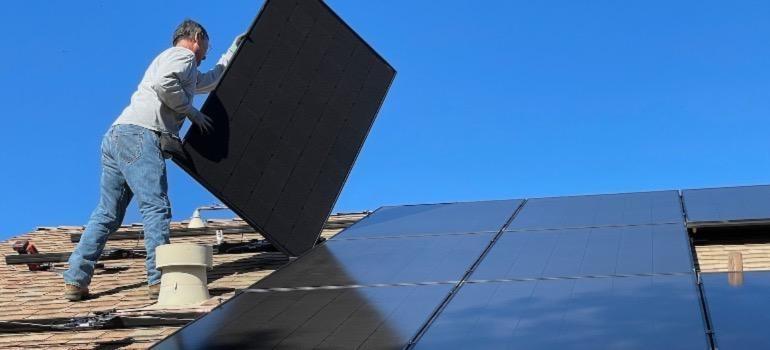Moving your solar panels can be a seamless process, allowing you to harness the power of renewable energy in your new home. Whether you’re relocating for a job opportunity, seeking a change of scenery, or finding the ideal home when starting a family, this guide is here to help you navigate the complexities of moving solar panels. By following the steps outlined below, you can ensure a successful transition and continue enjoying the benefits of solar energy.
Assessing the Feasibility of Moving Your Solar Panels
Evaluating the Current Solar Panel System
Before embarking on your move, it’s essential to assess the feasibility of moving the solar panels. Take note of the age and condition of the panels, considering whether they are due for maintenance or replacement. Evaluate the overall efficiency and performance of the system to determine if it’s worth moving or if an upgrade would be more beneficial. Additionally, assess the compatibility of the panels with the new location to ensure optimal energy generation.
Assessing the New Location
In order to make the most of your solar panels in your new home, it’s crucial to evaluate the suitability of the location. Consider the available sunlight and conduct a shading analysis to identify potential obstacles affecting panel performance. Structural considerations should also be taken into account to determine the best mounting options.
Lastly, research local regulations and permits to ensure compliance with specific requirements or restrictions.
Preparing for the Move
Hiring a Professional Solar Panel Mover
It’s advisable to enlist the services of a professional solar panel mover to ensure a safe and efficient move. Take the time to research reputable companies, comparing quotes and services offered. Verify licenses, insurance, and certifications to ensure you work with a reliable, experienced provider.
Choosing a professional mover can minimize the risk of damage to your solar panels during the transition. Doing this will also give you time to organize your home after the move while professionals handle the solar panels.
Scheduling the Move
Coordinate with the solar panel moving company and other service providers to establish a suitable timeline for the move. Consider any necessary repairs or upgrades that need to be addressed before the relocation. It’s essential to ensure a smooth power supply transition during the move to minimize downtime. By planning and organizing logistics, you can ensure a seamless move for your solar panels.
Disassembling and Packing the Solar Panels
Safety Precautions
During the process of disassembling and packing before moving your solar panels, it is crucial to prioritize safety to avoid accidents or damage. Begin by identifying potential risks and hazards associated with disassembly, such as working at heights or handling electrical connections.
Take appropriate safety measures, such as wearing protective gear like gloves, safety glasses, and non-slip footwear. Ensure all necessary safety equipment, such as ladders or scaffolding, is in good condition and used correctly. Exercise caution and follow proper procedures to avoid electrical shocks when handling electrical connections.
Additionally, ensure a clear understanding of the weight and dimensions of the solar panels to prevent strains or injuries. Of course, if you have professional help on your side, this can be made much easier.
Disconnecting the Solar Panels
Before disassembling the panels, shut down the solar panel system properly. Take care when handling electrical connections, ensuring they are disconnected safely. Remove the panels from their mounting structure, taking precautions to avoid damage.
Packing and Transporting the Solar Panels
Proper packing and transportation are essential to safeguard your solar panels during the move. Start by selecting suitable packaging materials that provide adequate protection against impacts and vibrations.
Use sturdy cardboard boxes or custom-made crates to house the panels securely. Use foam padding or bubble wrap to cushion the panels and prevent movement inside the packaging. Additionally, ensure that the panels are properly labeled with fragile stickers and directional arrows to indicate their orientation during handling and transportation.
When loading the panels onto the moving truck, secure them tightly to prevent shifting or sliding. Utilize straps, bungee cords, or padding to keep the panels in place and minimize the risk of damage. During transit, choose a reputable transportation service with experience handling fragile items. Regularly communicate with the movers to track the progress and ensure safe and timely delivery.
Reinstalling and Commissioning the Solar Panels
Assessing the New Mounting Options
Evaluate the new location and determine the best mounting system for your solar panels. Adapt the system to optimize its performance, taking advantage of the available sunlight. Make any necessary adjustments to ensure the panels are installed securely and in a manner that maximizes energy generation.
Reconnecting the Solar Panels
Properly wire the panels and the inverter, ensuring all connections are secure and correctly installed. Before commissioning the system, perform safety checks to verify everything is in order. This step is crucial to avoid any electrical issues or safety hazards.
System Testing and Commissioning
Once your solar panels have been reinstalled in the new location, thorough testing and commissioning are necessary to ensure optimal performance. Conduct a comprehensive system check to verify that all connections and wiring are secure and correctly installed.
Test the performance of individual panels, monitoring their output and efficiency. Use a solar monitoring system to track and record data, allowing you to analyze the system’s performance over time.
Additionally, troubleshoot any issues during the testing phase, such as poor connectivity or under performing panels. Adjust settings, if necessary, to maximize energy generation and system efficiency. Finally, ensure all safety measures and precautions, such as proper grounding and compliance with local electrical codes, are in place.
Using a Storage Unit for Safekeeping
During the process of moving your solar panels, it’s important to ensure the safety of your belongings as well. Consider using a storage unit to store your furniture, appliances, and other items during installation. This will keep your belongings safe from potential damage and keep them secure during the transition.
Updating Documentation and Contracts
Notifying Relevant Parties
Inform the utility company and grid operator about relocating your solar panels. Remember to provide them with the necessary information to ensure a seamless transition and continued energy supply. Remember to update your homeowner’s insurance policy to reflect the changes in your solar panel system.
Adjusting Contracts and Agreements
As you relocate your solar panels to your new home, it’s essential to make the necessary adjustments to any contracts and agreements related to your solar panel system. If you have a lease or financing arrangement, notify the relevant parties about your move and discuss the process of transferring the agreement to your new location.
Ensure that all terms and conditions, including payment schedules and contract durations, are updated to reflect the changes. Review the warranties and guarantees associated with your solar panels and ensure they are properly transferred to your new home.
This ensures that you maintain the coverage and protection provided by these agreements. It’s also an opportune time to explore any additional incentives, rebates, or tax benefits available in your new location.
To Wrap Up
Moving your solar panels doesn’t have to be a daunting task. By following this guide, you can navigate the complexities of the process and ensure a successful transition to your new home. Remember to assess the feasibility of moving your panels, hire a professional mover, take safety precautions, and update documentation and contracts.
By doing so, you’ll be able to both continue benefiting from renewable energy and boost your new home’s curb appeal. So, get ready to power your new home with sustainable energy, and make the most of your solar panels wherever life takes you.




